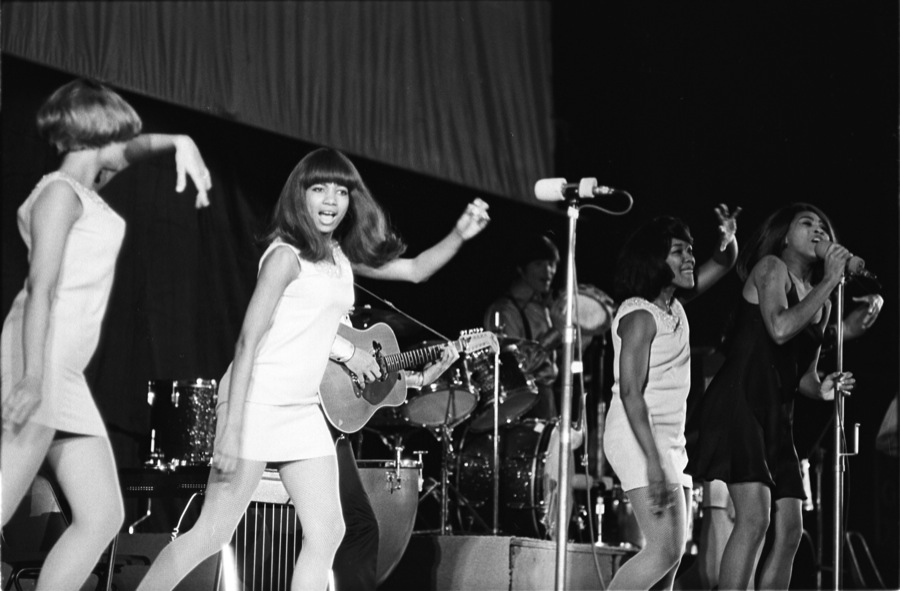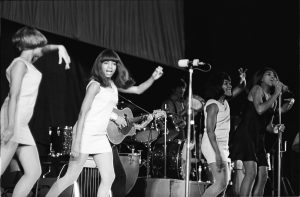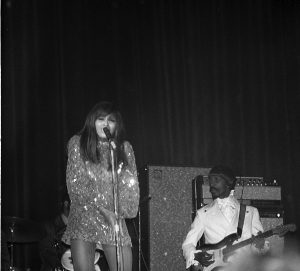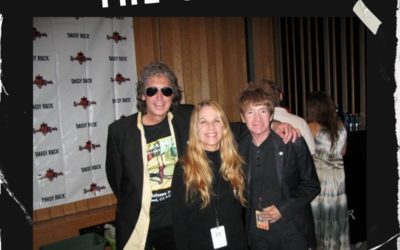Tina Musical Coming to Broadway In 2019
By Harvey Kubernik © 2018
Tina- The Tina Turner Musical based on the life story of Tina Turner, which opened on London’s West end in April 2018, that starred
Adrienne Warren, will be coming to Broadway in the fall of 2019.
The acclaimed West End show was directed by Phyllida Lloyd (Mamma Mia!). Playwright Katori Hall (The Mountaintop) collaborated on the book with Frank Katelaar and Kees Prins.
Tina Turner is associated with the production. On her official website, Turner displayed a statement about Tina.
“It’s really important to me to have the chance to share my full story. This musical is not about my stardom. It is about the journey I took to get there. Each night I want audiences to take away from the theatre that you can turn poison into medicine.”
Tina Turner was Ike Turner’s protégé long before establishing her own survivor’s identity, following well-chronicled deadly domestic abuse from Ike Turner, who she divorced in 1978, to an inspirational comeback saga, further documented in her 1986 international best-seller autobiography, I. Tina: My Life Story, published by William Morrow & Company.
In 1993 the biopic What’s Love Got to Do with It, loosely based on Turner’s life became a film directed by Brian Gibson, which starred Angela Bassett as Tina Turner. Ike Turner was portrayed by Laurence Fishburne.
On October 19th My Love Story, a second memoir from Turner was published by Atria, a division of Simon & Schuster. Expect more confessions and explosive details about former husband Ike Turner, Tina’s solo musical recordings, concert triumphs and romantic bliss over the last few decades.
In this autobiography Tina Turner reveals she was battling kidney disease in 2016 and underwent a kidney transplant in Switzerland during 2017 and the donor was her husband, Erwin Bach, a German record executive.
I think about Tina Turner today and the U.K. celebration show of her journey landing in New York during 2019. Tina’s revealing and healing rage comes to the Broadway stage.
I witnessed Ike & Tina Turner Revue dynamic performances a handful of occasions in the late sixties around Southern California.
I caught them in June 1969 as one of the support acts for the Jimi Hendrix Experience at Newport ’69 in Northridge, California. In November 1969 I experienced their act twice in one very long night on November 8th when The Rolling Stones ’69 U.S. tour rolled into Inglewood at the Fabulous Forum. Ike & Tina opened for The Monkees at the Hollywood Bowl in 1967.
On July 4, 1975 I saw the Ike & Tina Explosion at the Concerts at The Grove nightclub on Wilshire Blvd., formerly The Coconut Grove venue, at The Ambassador Hotel.
I reviewed it for the July 26, 1975 issue of Melody Maker. I wrote, “Tina, clad in a revealing black dress, stomped and romped in front of Ike’s impressive funky rhythms on guitar. Tina is on the brink of well- deserved solo success, and her forthcoming solo LP, along with her Tommy performance. Only makes her career with Ike even stronger.”
And now, thinking about Tina Turner, I am reminded of Tony Funches, a former Vietnam veteran, a friend from West Los Angeles College, who in November 1969 was head of Rolling Stones’ security and served as Mick Jagger’s bodyguard.
For some reason I didn’t see Tony on campus again during last quarter 1969 and all of 1970. I never knew why.
Needless to say, when I first saw the Altamont-themed movie Gimme Shelter with fellow classmate Bob Sherman in Hollywood, we immediately looked at each other when Tony Funches initially appeared on screen. In a Muscle Shoals recording studio session during a playback of “Wild Horses” and later protecting Jagger around the group’s airstream trailer in the madness of Altamont.
We both marveled, “Hey-isn’t that Tony from school?”
I am grateful to report in 2015 I re-connected with Tony Funches at the former residence of Jim Morrison in Laurel Canyon. In 1970 and ’71, Funches was a Jim Morrison confident and bodyguard.
Two friends and hardcore fans of The Doors encountered Tony at a hotel bar in Denver, Colorado. And when my name was mentioned, he immediately demanded my phone number.
When we rendezvoused, Tony had a copy of my Canyon of Dreams The Magic and Music of Laurel Canyon and wanted me to autograph it.
We talked for six hours, followed by a meal at Barney’s Beanery. Afterwards, Doors’ drummer John Densmore came by the house and drove Tony off.
Welcome to Hollywood…
That day Tony reminisced about that ’69 Rolling Stones/Ike and Tina Turner/B.B. King US tour.
“The Stones always supported black talent. I’ll give Keith and Mick props on this. Along with Charlie Watts and Mick Taylor, Ian Stewart, all of the Stones very early on, when I became associated with them, had no problem standing on their hind legs in front of me and extolling the virtues of all these artists that they had idolized as kids. And that impressed me quite a bit to hear that coming from them.
“Before the ’69 tour in Hollywood we saw Little Richard when he played the Whisky a Go Go. Mick and Keith jammed at Thee Experience with Bob Diddley and Mick saw Chuck Berry at the Whisky. And Mick and Keith and entourage went to the Ash Grove to check out Taj Mahal.
“I was with Mick and Keith when all the overdubbing and mixing were going down on the track ‘Gimme Shelter’ at Elektra Studios on La Cienega and then also at Sunset Sound.
“I remember The Ed Sullivan Show taping at Television City in Hollywood. Little Richard was in the audience. We also went to the Whisky to see Hugh Masekela and the Chicago Transit Authority.
“Mick Taylor visited Flash Records on East Vernon Ave. Keith wanted to take the Stones to the 5-4 Ballroom in downtown L.A. where Dinah Washington, Sam Cooke, Jackie Wilson, Muddy Waters and James Brown had played.
“They knew about the 5-4. And in fact, I told them, ‘You are not going in there. It’s upstairs, there is one door in and one stairway up and one stairway down. Once you are inside if the bullets start flying you got nowhere to go except fall over the balcony or get trampled by everybody tryin’ to run down the stairs. So forget about the 5-4. Do you understand me?’
“Etta James used to play the 5-4 and jumped off the bandstand. In fact, broke her wrist on one of the women in the audience, wrapped her hand up, climbed back up on the stage and finished her set. ‘Do you understand what I’m saying Keith? You aren’t going to the 5-4 Ballroom. Period!’
“The Stones are tied to the musical legacy of L.A. Modern and Kent Records. Ike and Tina along with B.B. King had been on both of those record labels.
“On that ’69 tour, Ike Turner led that band every night. A consummate professional. Ike had been in the business before I was born. He was part of the St. Louis and Chuck Berry rhythm and blues community and wound up in L.A. Anna Mae Bullock was from Nut Bush, Tennessee. Ike had his initial success as an arranger.
“Backstage Tina was busy. ‘Don’t mess with that woman. Leave her alone and stay out of her way.’ Yes she was gorgeous, but any woman who has that much energy and commands a room the way she can, give her space and peace. Stay out of her way. ‘Yes mam.’ Besides, Ike had a straight razor on him at all times. (Laughs). I ain’t ready to die over this woman.
“B.B. was a gentleman. Wonderful cat. I was aware of his manners, his professionalism, how kind he was to everybody. Not arrogant or rude. Gracious, polite, well spoken,” volunteered the late and memorable Funches.
Recently, while playing Ike & Tina Turner’s “I Idolize You,” and currently researching a1963-1973 period piece book about the Rolling Stones, I contacted the music journalist and esteemed author Stanley Booth and asked him to reflect on Tony.
Booth penned three books essential for any music library: Dance with the Devil: The Rolling Stones and Their Times, Rhythm Oil: A Journey Through the Music of the American South and Keith: Standing in the Shadows.
“I was with the Rolling Stones when I met Tony Funches,” emailed Booth. “Steve Stills and some of his crowd had a house somewhere in the vast and mysterious Hollywood Hills, and the Stones had rented it, among other places, for a few days before starting their 1969 United States tour. The first time I was at that house with the Stones, Tony greeted the car we were in at the front gate. He was, as ever, cool, pleasant, quiet, strong, competent. (Also big black and handsome.) I liked him right away and in the years since have never stopped liking him. Tony is one of Nature’s Noblemen. My life has been enriched by his friendship.
“Tony will not be forgotten.”
I admired bandleader Ike Turner as a founding father of the rock ‘n’ roll and just dug the way Tina and the Ikettes moved on stage and delivered the Ike-picked repertoire.
I was an avid collector of the recordings by the duo on the record labels Sue, Modern, Kent, Tangerine, A&M, Loma/Warner Bros., Blue Thumb, Minit, Liberty, and United Artists.
I fondly remember a fall 1975 interview I conducted with Tina Turner, following a dinner I had with her at Chasens restaurant near Beverly Hills.
Tina was quite impressed when I informed her as a youth I had lived with my family first in downtown Los Angeles, then in Crenshaw Village and graduated from West Los Angeles College in Culver City, which was near Inglewood and Bolic Sound, where she recorded with Ike and close to their house in View Park.
Our interview was published in the October 11, 1975 issue of Melody Maker. The headline read Tina Turner: Acid Queen.
“I’ve talked to a lot of reporters lately because of the Tommy movie and we decided to call the album, Acid Queen, to help capitalize on my role in the movie,” suggested Tina Turner in our 1975 interview at Bolic Sound studio, a seven-minute drive from her house in View Park, California, just outside Inglewood.
Clad in white jumpsuit, Tina is sharp, articulate and candid. The Turners’ musical revue is 15 years old, but it wasn’t until the late sixties that the American public finally accepted the intimacy of an Ike and Tina concert.
Brownsville, Tennessee, is the birthplace of Tina and she’s come a long way since she started her career singing as Annie Mae Bullock in talent shows and the gospel choir in Knoxville. In the mid-Fifties, Annie Mae moved to St. Louis with her sisters, and subsequently met Ike Turner. Tina soon joined Ike’s group, the Kings of Rhythm.
In 1959, Ike wrote a number entitled “A Fool in Love” for a singer who never showed up for the recording session. But Tina was familiar with it and filled in, since studio facilities were paid for in advance. The tune turned out to be a gem on Sue Records.
“River Deep, Mountain High” was a smash in England and the Come Together LP, which contained the hit Beatle tune and their cover of “Honky Tonk Woman,” climbed high on the national charts. Subsequent successes have included the million-selling “Proud Mary” single, a gold album What You Hear Is What You Get (Live At Carnegie Hall), and the hit single and album, Nutbush City Limits.
“We toured for years with all the English groups and I always liked what they were singing about,” enthused Tina, who in 1966 at Colston Hall in Bristol, England in a hallway corridor taught Mick Jagger an interpretation of the sideways pony dance in front of Marianne Faithfull, Brian Jones, and Keith Richards.
“I’ve wanted to do an album like Acid Queen for some time,” she explained. “There’s a lot of Mick Jagger’s songs that we haven’t gotten around to doing. The concept of the album came from my producers, Denny Diante and Spencer Proffer. At first the album was going to be called, The British Album, with the whole album full of British songs.”
There are four other English numbers on the album: “Under My Thumb,” “Whole Lotta Love,” “’I Can See For Miles,” and “Let’s Spend The Night Together,” which complete the first side. Side two features five original compositions, with “Rockin’ And Rollin” and “Baby – Get It On” the most striking.
“But Ike sent out word that he wanted the album out immediately,” said Tina, “so after I did a commercial for Dr. Pepper, earlier in the day, I did the vocals at nine o’clock in the evening and hardly got a chance to learn the songs.
“The album was a bit rushed, but I’ve done it this way before. We’ve done a lot of albums without spending that much time on them. All that was left was for me to cut the vocals ’cause Ike, Denny and Spence got everything else together.
“We were in Seattle a few years ago in a record store and I heard this bass riff opening on ‘Come Together.’ I said ‘I had to do that song,’ the same with ‘Proud Mary.’ I’ve been trying to get Ike for two years to record it. We’ve always done other people’s songs successfully and it’s not uncomfortable doing songs by the Who, Led Zeppelin and the Stones.
“Ike and I haven’t got the time to develop as songwriters ’cause we spend so much time in the studio and on the road. And there’s a lot of good music to be covered.”
She’s very much a solo force these days, and for the first time there are press kits with pictures of Tina sans Ike. “It’s still the Ike and Tina show,” she reinforced. “Ike and I are singing a bit more together on stage, and maybe all the Tommy promotion has put a bit more of the focus on myself.
“We’ve been trying all these years to get to the point where the whole show is sharp. When we went into Las Vegas we changed the show around and the Ikettes added six songs to the repertoire. They’re much better now. All these years we’ve wanted the whole package to be good.
“Ike selects the songs and there’s a tremendous amount of preparation for our tours.”
Her Tommy cameo appearance seemed to get the most applause from theatre patrons. Ike & Tina’s previous celluloid performances. The Big TNT Show, Gimme Shelter, and Soul To Soul, just mirrored the show act.
“Tommy was a whole new trip for me, getting into a room and turning into a mad woman. At first I didn’t want to play the part of a prostitute. But it was a challenge and it called for drama. That’s what acting is all about.
“Travelling across the country now people are beginning to know me as the ‘Acid Queen.’ The audience is screaming for the song when we perform live.”
Sexuality has become a trademark of the Ike and Tina spectacle. Her use of bold expression, unlike most performers, goes beyond the tease category. Some felt the show exploits sex. Whatever, no-one talks when she performs.
The show is toned down for the supper club circuit; a slight degree of hesitation, but there’s always a huge amount of suggestiveness.
But, she sternly says: “I never felt we’ve used sex as a gimmick in our program. It’s important today because, people who pay to see a show want a little of everything.
“The sexual portion of our show isn’t planned; it just happens. It works out well visually and it always seems to get the most audience response. Everybody needs an image. There’s a million groups out today; flipping, smoke bombs, dancing – fortunately, everybody can’t be sexy. We’ve discussed it a thousand times. The miniskirts and see-through dresses.
“People’s minds do wander. We may do a song like ‘I’ve Been Loving You Too Long,’ and work with it. Every time we do it, the song changes. Sometimes I really have a lot of fun with that song because people expect something to happen.
“For years we’ve gotten reviews that seem to dwell on the sexual aspect of the show. I’ve never felt people gaining sexuality after seeing our show. But I like them to remember what they have just seen. I’ve never really thought of our show as being aggressive. Even as wild as I am I know that I maintain my femininity. People have always told me that.”
The times have changed for the black musicians and entertainers. Tina cited some of the horrible scenes and often miserable bookings where there weren’t places to sleep, the tour bus never got a chance to stop and band members were subject to numerous racial incidents.
“The biggest change started happening when we were working around L.A. in 1966 and ran into Phil Spector,” recalled Tina. “He wanted to record me and when we cut ‘River Deep, Mountain High’ Mick Jagger, who was visiting Phil at the time, was in the studio.”
In a 1988 interview with arranger Jack Nitzsche at his Hollywood Hills residence, Jack discussed “River Deep, Mountain High” and the landmark recording session at Gold Star studio. Brian Wilson, Dennis Hopper, Mick Jagger and Rodney Bingenheimer were in attendance. The song written by Jeff Barry, Ellie Greenwich and Spector, was released initially on Spector’s Philles Records.
“Phil was the co-writer on the song. Phil embellished the song and was the producer. I’ve talked to Gerry Goffin about that a lot; Phil co-writing songs that he would produce. Phil would always have the writers come over and write in the room with him, and I knew he directed it. They all say the same thing; that without Phil Spector in the room that song wouldn’t have been that way. He helped. He knew what he wanted it to be. I know Phil Spector helped write ‘River Deep, Mountain High.’ Phil said, ‘I’ve got a song for Tina.’ I went over to Phil’s house and went over the arrangement note by note. When Phil played me ‘River Deep, Mountain High’ on the piano I knew it was a great song.
“We did the rhythm track in two different three-hour sessions. Even during the cutting of the track, when she was putting on a scratch vocal, Tina was singing along as we cut it. Oh, man, she was great, doing a rough, scratch vocal as the musicians really kicked the rhythm section in the ass.
“Tina was the vocalist. Background groups doubling and tripling so it would sound like two or three dozen voices. Phil would spend a lot of time with the singers. I would split and he’d still be working on lines with the singers. The rhythm section and the horns were done together. Vocals and string parts were overdubbed later,” explained Jack.
“Once in a while a vocalist would run through a song, but this time Tina made everybody play better. When I first heard the intro I didn’t like it very much, but once it was being recorded it all made sense. It was real good.”
“I like to have all the musicians there at once,” Spector stressed to me in a 1977 interview conducted with him inside his Beverly Hills mansion for the new defunct Melody Maker. “I put everything on 24 tracks just to see if it’s plugged in. The finished track never ends up on more than one track. I record basic tracks and then put it all onto one track or maybe two. The musicians I have never outdo me. I’m not in competition with them. I’m in complete accord with them. Then I condense. I put my voices on. Singers are instruments. They are tools to be worked with.
“You tell me how many names you immediately remember in the cast. One? Two? It’s the same with Fellini, and that’s what I wanted to do when I directed a recording.”
“River Deep, Mountain High” only reached number 88 in the U.S. Billboard singles chart, but a number 3 position in the U.K. market.
John Lennon called “River Deep, Mountain High” a “masterpiece.” George Harrison provided a front jacket blurb on the Spector produced Ike & Tina Turner River Deep, Mountain High album: “It is a perfect record from start to finish. You couldn’t improve on it.”
“River Deep, Mountain High” also impressed Mick Jagger.
In our 1975 interview, Tina reminisced, “After hearing the song he wanted us to tour England in 1966 with the Rolling Stones. The English weren’t used to seeing girls with high-heeled shows and I think they were shocked a bit.”
In 2007 I asked Andrew Loog Oldham, who managed the Rolling Stones and produced their 1963-1967 recordings, about that fabled 1966 tour.
In ‘66 Oldham hailed “River Deep, Mountain High” in his own paid-for advertisement in the weekly Disc and Music Echo periodical.
“The ’66 tour with Ike & Tina Turner and the Yardbirds was a give something-back-to-the- fans-type of thing. Ike & Tina were a 17-piece review; you were not making money putting them on the bill.
“On top of that, Tina had had the Phil Spector record in July, ‘River Deep, Mountain High,’ that we had championed and if we, the Stones and I, were not going to bring them over– nobody else was. And the U.K. deserved to see what we had been fortunate enough to witness in the U.S. Long John Baldry was the host of that tour. We had so much music on the bill we could only offer him the compere spot. John was the beginning for so many- the hope. We wanted to honor that by having him on the tour.”
“Mick then came to the States in 1969 and asked us to tour America with him later in the year,” confirmed Tina in our 1975 dialogue. “That’s when it happened.
“We played the Forum, Madison Square Garden, and all the big arenas. Like Vogue said it best: ‘They came to see Mick Jagger but they saw Ike and Tina and they’ve been comin’ ever since.’ From there on we crossed over to the pop market and it’s been that way ever since.
“We just returned from a tour in Southern France and every night we got three, four and five encores. We’re much bigger in Europe than here in America. We’d need a lot of hits to be as big here. I feel we’re totally accepted in Europe. I’ll always remember Europe and England for making ‘River Deep, Mountain High’ a hit.’”
In 1975, Tommy brought a rash of talk show interviews for Tina, and national and local press coverage has bloomed. The press in general, however, has exploited the Turners, while turning up nasty rumors and juicy gossip.
“I’m not a worrier. I’ve read a few things over the years that I laugh about. ‘She must be over 50’ or, ‘Ike messes around with the Ikettes.’ It goes in one ear and out the other. We laugh about it. If it’s really shocking you can’t let it bother you.” Then she grins. “Some of it is true. There are a few incidents that I can’t live down, like the time in Las Vegas when I was running around the stage in my heels and I slipped because we were using the bubble machine. Wham!
“I fell, spread out across the floor, with my crotch to the audience. Luckily I wasn’t hurt.”
© Harvey Kubernik, 1975 © 2018
(Harvey Kubernik is the author of 15 books, including titles on Leonard Cohen and Neil Young. His 2017 volume, the acclaimed 1967 A Complete Rock History of the Summer of Love was published by Sterling/Barnes and Noble. His Inside Cave Hollywood: The Harvey Kubernik Music InnerViews and InterViews Collection, Vol. 1 was published in December 2017, by Cave Hollywood. Kubernik’s The Doors Summer’s Gone was published by Other Cottage Industries in March 2018.
In November 2018, Sterling/Barnes and Noble will publish Harvey’s book, The Story of The Band From Pig Pink to The Last Waltz, written with brother Kenneth Kubernik.
Harvey Kubernik’s 1995 interview, Berry Gordy: A Conversation With Mr. Motown, that initially was published in 1995 in Goldmine and HITS magazines has just been licensed for inclusion in The Pop, Rock & Soul Reader edited by David Brackett to be published in 2019 by Oxford University Press.
This century Harvey penned the liner note booklets to the CD re-releases of Carole King’s Tapestry, Allen Ginsberg’s Kaddish, Elvis Presley The ’68 Comeback Special and The Ramones’ End of the Century.
In November 2006, Harvey Kubernik was a featured speaker discussing audiotape preservation and archiving at special hearings called by The Library of Congress and held in Hollywood, California).








